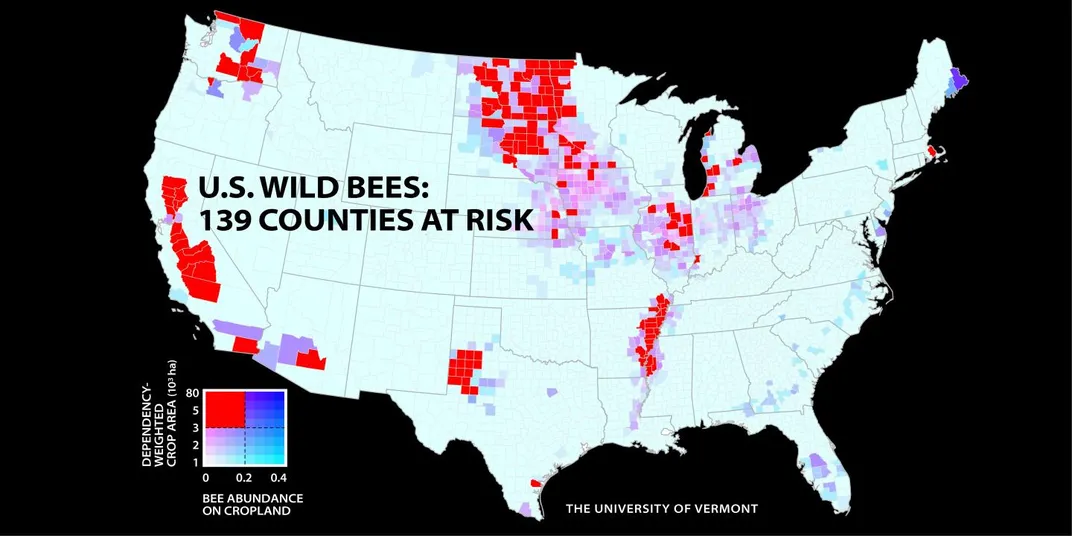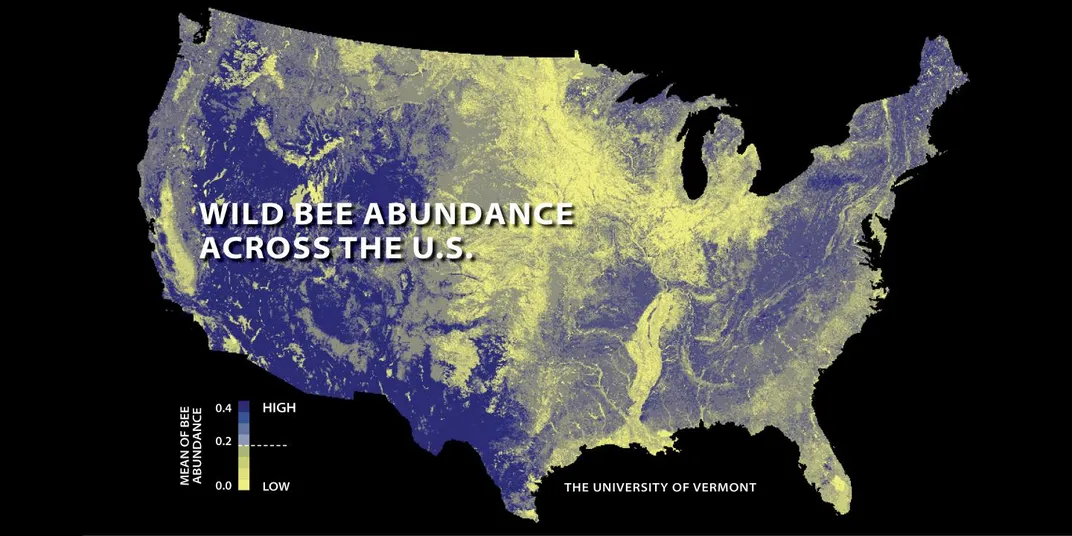New Map Highlights Bee Population Declines Across the U.S.
As wild bee populations continue to fall, new research identifies counties that will be hit the hardest
/https://tf-cmsv2-smithsonianmag-media.s3.amazonaws.com/filer/45/3b/453b6997-ab82-4295-84ba-777acdecafd0/7877840520_864e77dd61_o.jpg)
Though they’re tiny, bees play a big role in making our food. But these fuzzy fliers are in trouble—and a new map highlights just how precarious the pollinator’s situation has become in the United States.
Recently presented at the American Association for the Advancement of Science (AAAS) annual meeting, the map highlights 139 counties across the country where wild bees are at risk. Many of these danger regions encompass major agricultural zones like California’s Central Valley and a wide swath of the Great Plains.
“This study provides the first national picture of wild bees and their impacts on pollination," Taylor Ricketts, conservation ecologist at the University of Vermont and one of the study’s authors, says in a press release.
Ricketts and his team created the maps by identifying 45 types of land cover from two federal databases. They then queried bee experts around the country about how well each land cover type provides wild bees with nesting and food resources. From this information, the researchers built a model that predicts the relative abundance of wild bees across the contiguous U.S., which they tested against bee collections and field observations. The researchers published their study last year in the journal Proceedings of the National Academy of Sciences.
Bees, and other pollinators, play an outsized role in the global agriculture industry. According to a 2016 United Nations report, pollinators drive up to almost 600 billion dollars a year in income globally. But these tiny workers are in trouble. The UN report suggests that roughly two out of five invertebrate pollinators, including bees, are threatened by extinction. As Ricketts and his collaborators reported, models of wild bee abundance show declines of roughly 23 percent across the contiguous U.S. from 2008 to 2013.
Bees face a perfect storm of pressures, reports Charlie Wood for the Christian Science Monitor. Among these challenges are changes in land use, the rise in monocrop agriculture, pesticide use, invasive species, diseases and climate change, according to the UN report. These many factors may also play into colony collapse disorder—which is when the worker bees suddenly disappear from the hive, abandoning queen and nurse bees.
Of all the challenges bees face, the loss of their native habitats may have had the greatest impact, according to this latest study. In regions where bee populations are struggling within 11 key states (areas with the greatest declines), the amount of land converted from grasslands and pastures to corn production spiked by 200 percent in five years. In that same period, native habitats converted for grain production spiked by 100 percent.
Many of the counties experiencing this growth in cropland are also facing increased demands for pollination, creating a mismatch of rising demand and declining wild bee populations.
Ricketts maintains an optimistic perspective that the buzzing pollinators can continue to produce billions of dollars in agricultural income if managed properly. "The good news about bees," Ricketts says in the press release, "is now that we know where to focus conservation efforts, paired with all we know about what bees need, habitat-wise, there is hope for preserving wild bees."
Editor's note, February 24, 2017: The image for this article originally pictured a bee in Europe; the map only applies to North America.

